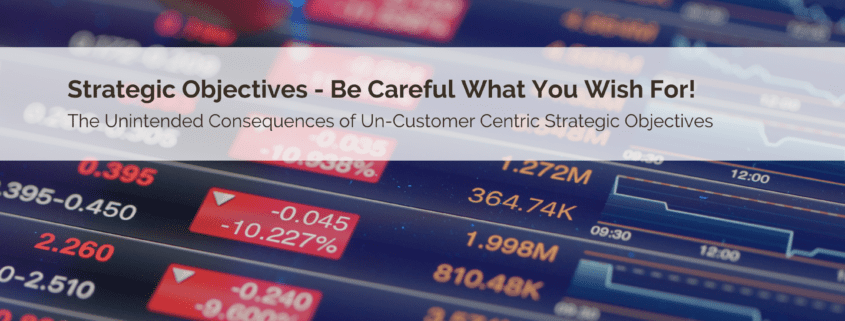Strategic Objectives – Be Careful What You Wish For!
Strategic Objectives – Be Careful What You Wish For!
The Unintended Consequences of Un-Customer Centric Strategic Objectives
Many of you be aware of the Netflix feature documentary “Downfall: The Case Against Boeing”, which tells the catastrophic story of the launch, crashes, suspension, inquiries, and consequences of the 737 Max’s early life.
The documentary generated much coverage, e.g. in The Guardian in the UK, much of which rightly focused on the victims, the regulation, and Boeing’s mishandling of the crisis. I’d highly recommend that you watch it if you haven’t already.
Over-and-above the human tragedy, the one thing that stuck in my mind was the intentional shift from the new leadership of the company to make the share price their primary strategic objective. The case is made that this directly led to the toxic blame culture, corner-cutting behaviours, and fear of speaking out that nearly sunk the company (indeed would have sunk other companies that weren’t “too big to fail”).
Of course, a healthy share price is a good thing, but I’d argue that it’s a poor strategic objective as it can be manipulated in many ways that have nothing to do with the core activities of profitably developing products and services, and selling to and servicing customers. The share price should be a positive result or outcome of your strategic objectives, not your purpose in business. I would argue that your purpose and strategy need to be customer centric.
Here are some other un-customer centric strategic objectives that I have seen, and their unintended consequences:
| Market Share | · Misalignment of how analysts define “the market” with your target customer profiles
· Culture of “don’t care who buys, as long as someone does” · Selling on price rather than value – race to the bottom · Numerous customers on the database who have only bought once from you, often in response to an offer |
| Internal Product / Departmental Competition | · Silo mentality – knowledge is power; lack of collaboration
· Disjointed customer experience · Duplicated account management · No recognition of high overall value customers |
| Revenue | · Toxic, short-termist sales culture – only as good as this quarter’s performance
· Acquisition of ‘bad’ customers just to make the numbers · Mis-selling and ‘phantom’ sales · Key Accounts based purely on volume rather than profitability, opportunity or strategic alignment (partnering, etc.) · The wrong “heroes” celebrated – “revenue is vanity, profit is sanity” |
| Beating the Competition | · Obsessing about competitors rather than customers
· Focus and resource spent on reacting to competitors’ products and campaigns rather than understanding and meeting your customer needs |
| Top CSat or NPS | · Industry studies can’t distinguish perception from reality – often the company with the biggest marketing budget gets the best sector CSat scores
· Manipulation of data and results (e.g. exclude the complainers, NPS “begging”) · It all becomes about the number, not the customer experience behind it · A new entrant or niche player beats you. So what? |
Are you thinking “Oh no, you’ve just described my company”?!
I’m not saying that these shouldn’t be measured and celebrated when positive results are achieved. I am saying that along with share price they’re not the best to define your purpose in business, and how you will track/achieve that purpose.
Here are some customer centric strategic objectives (with links for more detail) that will lead to sustainable success – and high performance in many of the outcomes mentioned above without the unintended consequences:
- Trust – the Boeing story is a woeful tale of destroying trust that had taken decades to build. Why do you only hear trust talked about after a company has lost it?!
- Customer Value / Profitability – long-term value and loyalty rather than short-term “heroes”; cross-selling and up-selling; share-of-spend; optimised cost-to-serve; key accounts and strategic partnerships based on value and opportunity
- Joined-up Customer Journey – across channels, products and account management structures
- Customer AND Staff Experience – why are these managed completely separately when we know they’re interconnected?
- Collaborative Innovation – are your drivers of innovation aligned to un-customer centric strategic objectives?
We can help you align your strategic objectives with a customer centric purpose to produce profitable, sustainable and trust-building outcomes.
 Please get in touch to discuss your challenges and how our methods and approach can lead to a cultural breakthrough in your business.
Please get in touch to discuss your challenges and how our methods and approach can lead to a cultural breakthrough in your business.
- Customer Strategy in the B2B Membership Sector - May 27, 2025
- Build a B2B Customer Strategy - May 20, 2025
- Should you implement NPS in B2B? - January 22, 2025





